All published articles of this journal are available on ScienceDirect.
Analysis of the Environmental Impact of the Energy Retrofitting Carried Out in a Low-income Residential Neighbourhood. The Case of Juan XXIII in Alicante, Spain
Abstract
This article presents the analysis of the improvement measures applied on an energy retrofitting carried out to 324 dwellings built in 1967 at Juan XXIII neighbourhood in Alicante (Spain). The impact on consumption reduction and the cost of each measure are shown. The neighbourhood presents significant levels of urban obsolescence, partly motivated by the poor constructive quality caused by the intense rhythm followed during its construction. Furthermore, at that time, Spain lacked specific regulations on energy saving issues. The latter is the reason why the buildings have an evident inefficient behaviour. In addition to all this, there is a significant social and economic vulnerability in the neighbourhood, with dysfunctional families and high unemployment levels.
All of the stages of the retrofitting process are presented, starting from the identification and characterization of constructive elements in their original state to the analysis of the improvement measures and the energy evaluation and used tools. Finally, these are demonstrated as the improvements in energy efficiency can produce a better quality life for the inhabitants, constituting a powerful strategy to dignify a neighbourhood, from environmental, social and economic aspects.
INTRODUCTION
Regulatory Context
The building sector has become a strategic area in order to accomplish the aims established by the Kyoto Protocol 20-20-20 [1]. The European Commission published Directive 2002/91/CE of the European Parliament and Council of the 16th of December, 2002 relative to Energy Efficiency in Buildings (EPDB) [2], which was merged in Directive 2010/31/EU of 19th May, 2010 obliging European countries to meet a number of minimum requirements for energy efficiency in buildings and their facilities.
The EPDB [3] is a legal tool that advocates for an efficient energy consumption in the building sector at European level, combining prescriptive tools (it requires Member States to establish energy efficiency requirements for new buildings and those existing which are subjected to refurbishment) and informative tools (such as the emission of energy efficiency certificates at the moment of buying, selling or leasing and requirements for heating and cooling system inspections).
In Spain, this directive has been transposed through various instruments:
- Royal Decree 314/2006 [4] approved the Technical Code on Building and its later renewal of the Basic Document Energy Savings (DB HE) on the version published on the 12th of September, 2013 [5].
- The Rules of thermal systems in building, approved in 2007 and its later renewal through the Royal Decree 238/2013 [6].
- Royal Decree 235/2013 approved on 5th of April, presenting the basic procedure for energy efficiency certification in buildings [7].
Energy Retrofitting in Buildings
According to data obtained from Rehenergía project [8], there is a potential for energy savings between 12% and 40% for energy consumption reduction through intervention on façades, rooftops and windows.
Also, according to data from “Study of potential for energy savings and reduction of CO2 emissions in dwellings of the Valencian Region” [9] on “Distribution of multifamily homes by typology in the Valencian Region”, the most common building (53%) in the Valencian Region is the isolated apartment block, which is linear and compact and is the subject of the present study.
There are various studies on energy savings obtained in different energy retrofitting experiences on the residential building stock nationwide as elaborated by WWF [10] or the RECONSOST Project [11], all of them focusing on energy refurbishment measures. The recent study “A vision-country for the Building Sector in Spain”, by Green Building Council (GBC), [12] intends to reveal that with the adequate regulatory framework, rehabilitating and updating the building stock are a feasible and economically possible action, and must stand as the activity over which the building sector should restart in Spain, currently insolvent to face the challenges on Climate Change and terribly affected by the crisis.
DESCRIPTION
From 1940 to 1980, the construction of new buildings in Spain went through a process of unprecedented growth. Therefore, the current building stock includes a significant proportion of buildings constructed during that period. The main problem is that these buildings were designed and constructed with a lack of technical regulation on sustainability. The Basic Regulation on Thermal Conditions of Buildings [13] was published in 1979, so it is difficult to find façades and rooftops that embed thermal insulation before that date.
From all of the environmental impacts originated from this situation, the most alarming are energy consumption and CO2 emissions. This is why policies from different Public Administrations are at this moment, focused on diminishing this situation.
It is important to remember that according to the European Commission [3], buildings are responsible for 40% of the final energy consumption in the European Union. In the same document, the intervention on energy efficiency at buildings is considered as the second area with the most savings potential after energy production. For both the reasons, the European Commission considers the intervention on the building sector a priority, both via regulation on new buildings and improvement of the existing ones, in order to modify the current trends in the reduction of energy consumption in the European Union, which are far from the objectives set for 2020.
Merging the fulfilment of the European commitments with the poor comfort conditions of the buildings constructed prior to 1980 in Spain, energy retrofitting appears as an unavoidable solution. On top of that, we must not forget that energy retrofitting has a wide impact, on one hand, on job creation, as it represents an opportunity to retrieve industrial and professional activity within the construction sector, and on the other hand, to end the increasing energy poverty situation that some areas of the society suffer due to the rising energy prices, as described by the Association of Environmental Sciences (ACA). This situation increases the number of people who live under a profile of energy poverty.
In this context, the Municipal Housing Board of Alicante in 2010, approved a project “Retrofitting of the common elements in buildings at Juan XXIII neighbourhood”. Its purpose was to refurbish façades and rooftops of three apartment blocks in order to improve their quality, comfort and energy efficiency. They included 324 dwellings occupied mainly by low-income neighbours and located at the city of Alicante (Valencian Community, Spain), (Fig. 1).

The three groups of housing block refurbished are open building with rectangular-shape floor plan, very characteristic in residential estates for social housing built during the '60s. These type of buildings emerged with a very high rate of construction in response to the high demand for housing, caused mainly by the migration of people from the countryside to cities searching for new employments.
As commented in the introduction, during the ‘60s, there was no legislation on energy efficiency and it was only in 1979 that the first regulation on the implementation of thermal insulation on the buildings’ envelope appeared [13]. Therefore, these buildings became notable energy consumers to guarantee interior thermal comfort conditions. The continuous increase in energy prices caused that many low-income families, which are the most common inhabitants of these buildings, could not afford paying their energy bills, so they began to live under discomfort conditions, which emplace them into health risk conditions, known as energy poverty [14] (families that have to take more than 10% of their income to pay for the energy bills).
Moreover, the geographic concentration of obsolete buildings has resulted in degraded urban areas thereby increasing the vulnerability of their populations and concentration of groups at risk of exclusion. At the specific neighbourhood of the described intervention, the socioeconomic situation is precarious. According to database from the city council of Alicante, a fifth part of the population is poor in this neighbourhood. Some neighbours have difficulties covering the basic needs and are unemployed or engaged in outlaw activities.
Consequently, energy retrofitting of this housing stock becomes an unavoidable need for current housing policies. New policies must include financial mechanisms that allow improvements on the energy efficiency of these buildings through economically feasible projects that allow payback in reasonable timing and introducing new agents, like energy services companies, that offer the possibility of assuming the interventions’ initial investment; otherwise, it will be a boundless challenge.
Given this context, it is necessary to develop researches such as this one, that analyse experiences on energy refurbishment carried out on representative groups, allowing the extraction of ideas or conclusions in order to set optimal measures on energy efficiency at buildings occupied by low-income families.
MAIN PURPOSE
The study presented was developed by the Valencia Institute of Buildings (IVE from now on), and established by agreement with the Valencian Regional Government, the Municipal Housing Board of Alicante and IVE. The main goal was to carry out an analysis of the energy efficiency of the renovation of the buildings in Juan XXIII neighbourhood previously mentioned. The result may allow extracting conclusions on how to proceed in future interventions in a more efficient manner.
This implied to:
- Set a record of the initial energy demand and energy consumption before the retrofitting works, and then after the works have been concluded.
- Evaluate the proposed measures to improve the energy efficiency of the thermal envelope, in order to decrease the CO2 emissions.
- Compare the improvements of different strategies on energy savings and reduction of CO2 emissions, including those proposed in the initial project, in order to optimize and capitalize to a maximum level the resources to spend in similar future actions.
METHODOLOGY
In order to face energy evaluation on buildings, the following stages were followed:
Preliminary Data Collection
This first stage was aimed to collect general information about the neighbourhood and its history, social and economic aspects, as well as administrative, graphs and technical information, which may give a greater knowledge of the buildings. Accordingly, all the information available in institutions and entities such as Professional Technical Schools, Municipal Archive of Alicante, and Projects Coordination Service of the City of Alicante, Municipal Housing Board of Alicante and the Cadastral Virtual Office was consulted.
Complementary Data Collection: Technical Visits to the Buildings
The main aim in this stage was to search for complementary data on site, mainly technical, that allowed a characterization of the initial state of the buildings’ thermal envelope and DHW, heating and cooling systems.
A series of technical visits to the buildings were scheduled for visual inspection, only including a series of tests and samples that allowed the identification of each constructive element of the building envelope and the materials of which they were constituted.
Of all of the buildings’ envelope characteristics, the most interesting were those needed to obtain the thermal transmittance U (W/m2K) of each constructive element, as well as the ones related to the air leaks.
Energy Evaluation of Both Current and Improved State
Once all the information had been gathered, a computer program was used to be able to measure energy demand, energy consumption and CO2 emissions. This program was also able to assess these data after applying the proposed measures for improving the buildings’ envelope. This program was CERMA (Calificación Energética Residencial Método Abreviado) in its version for retrofitting of existing buildings (it is also used for new buildings). Fredsol group, at the Polytechnic University of Valencia and the Valencia Institute of Buildings, developed this tool [15].
The CERMA application used for the energy evaluation already included the requirements established by Spanish regulation (Building Technical Code), for Alicante city. It also included the correlation between energy consumption and CO2 emissions defined by the Spanish government.
RESULTS
Preliminary Considerations
Alicante’s Climatology
Alicante is a typical Mediterranean city, with mild winters and hot summers. The following Graph (1) shows the average monthly temperatures for Alicante. It can be seen how at winter temperature rarely drops below 10ºC, with minimum temperatures around 7ºC. At summer, the temperature exceeds 25 ºC, with maximum being just above 30ºC.
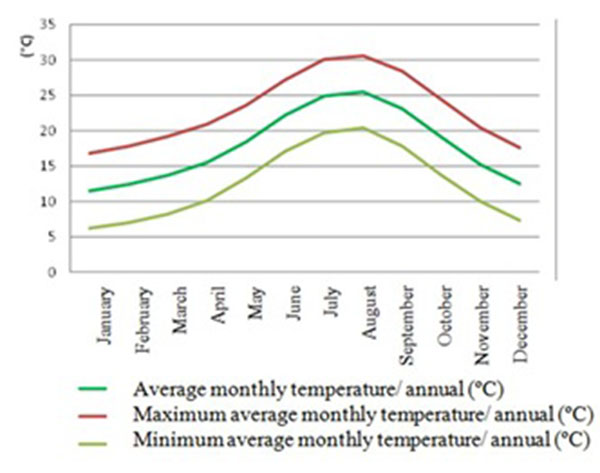
Building Typology
Each block is set by linearly terraced modules, due to the lands’ characteristics; some are arranged in stepwise way, both at height and at alignment regarding the next block (Fig. 2). This is shown more clearly in Fig. (12).
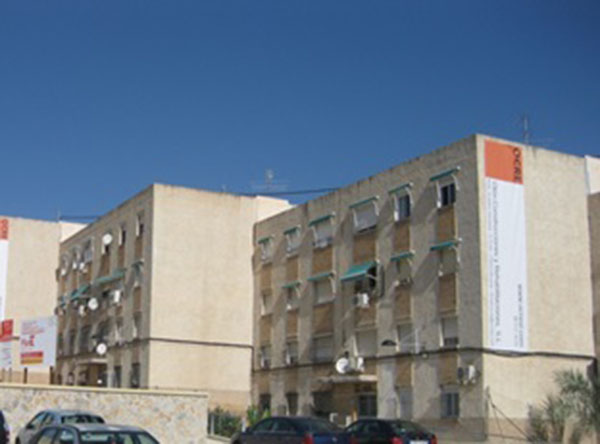
There are 3 and 4 floors modules. Each module consists of 4 dwellings per floor, including the ground floor. Each dwelling consists of 3 bedrooms, living room, kitchen and one bathroom. Except the bathroom, the rest of the rooms receive light from the outside, both from the front façades as from the light coming from the two inner courtyards in each module. (Fig. 3).
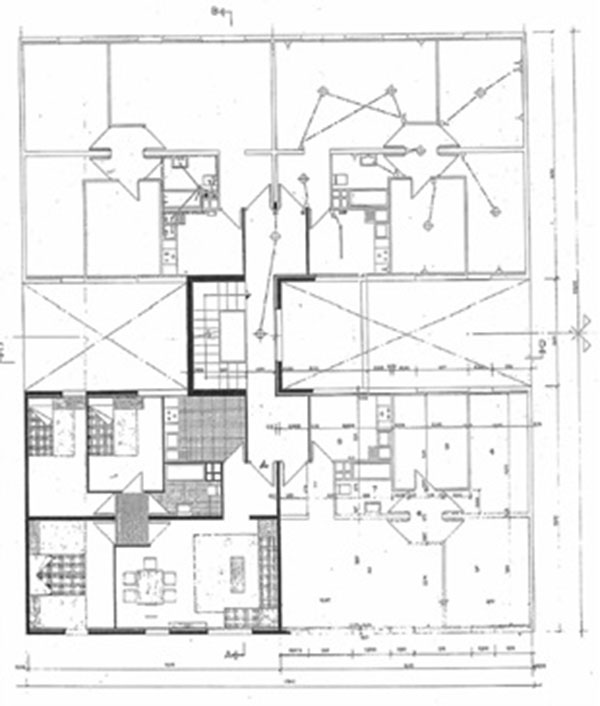
Each dwelling has an area of approximately 72 m2 built. Group 1 consists of 116 dwellings, (8,350 m2 built), group 2 consists of 92 dwellings (6,624 m2 built) and group 3 of 116 dwellings (8,350 m2 built). Altogether, 324 dwellings with a total area of 23,324 m2 are built.
Results From the Data Collection
Constructive Characteristics at the Original Status
The façades and roofs characterization was done by piercing the elements and checking the different material layers (Figs. 4 and 6).
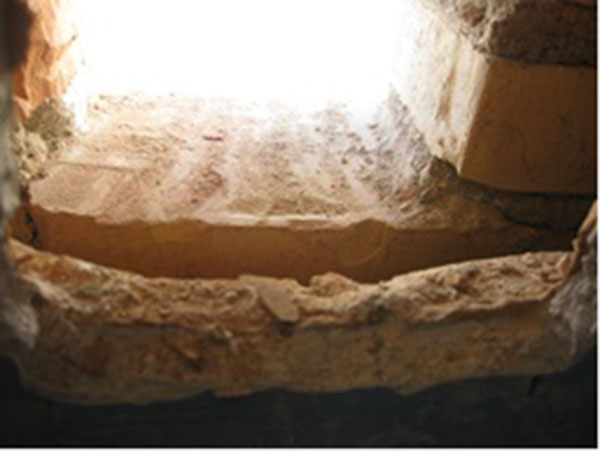
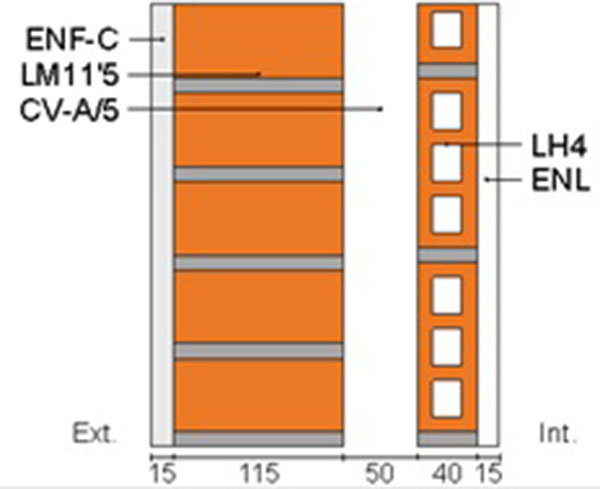
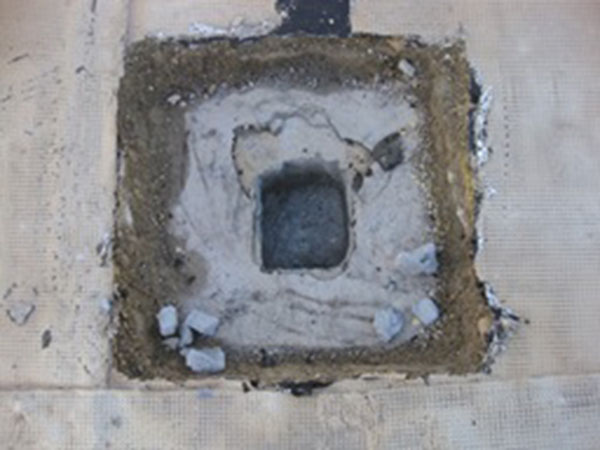
The façades consist of exterior double walls with interior air chamber (Fig. 4). The detailed composition, shown in Fig. (5), is as follows:
- − Plaster with cement mortar coating, ENF-C
- − Solid ceramic brick, 115 mm, LM11,5
- − 50 mm air chamber, not ventilated, CV-A/5
- − Hollow ceramic brick, 40 mm, LH4
- − Plaster coating, ENL
- − Thermal transmittance coefficient U (W/m2K): 1.64
Rooftops are plane surfaces using Catalonian ceramic tile pavement. However, some modifications were detected during the inspections using rainproof auto-protection roof sheets and paint used for repairing continuous water leaks due to water migration. (Fig. 6).
The detailed composition is as follows (Fig. 7):
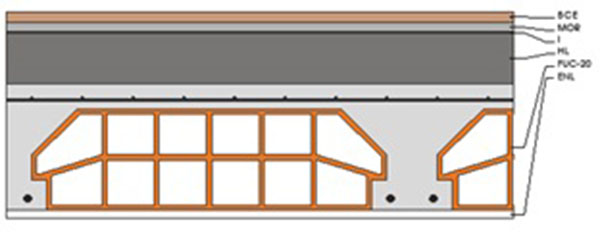
- − Ceramic tile, BCE
- − Holding mortar, MOR
- − Waterproof layer, I
- − Light aggregate concrete for sloping, HL
- − One way floor of pre-stressed joists 200 mm edgewise, FUC-20
- − Plaster coating, ENL
- − Thermal transmittance coefficient U (W/m2K): 1.61
The original windows were double winged with steel frame and 4mm monolithic glass, (Thermal transmittance coefficient U (W/m2K): 5.7).

Most of the thermal systems lacked heating and cooling, although they had domestic hot water through a boiler that ran on butane gas bottle (Fig. 8).

Energy Improvement Solutions
Mainly, the adopted solutions aim was to thermally insulate both façades and rooftops. Regarding the windows, it was decided to install new ones, without removing the originals, so the final solution is a double window (Fig. 9).
The solution consisted of doubling the current windows, by placing the new ones on the outside, attached by galvanized steel frames, pinned to the façade. The new windows can slide horizontally, having two wings and including a roller shutter box. The data disclosed by the manufacturer through the respective certificate as follows:
- − Metalwork: White lacquered aluminium, no thermal bridge breakage. Thermal transmittance coefficient U (W/m2K): 6.3.
- − Two double sheet glasses, 4mm per sheet, with a 6mm air chamber in between. Thermal transmittance coefficient U (W/m2K):3.3.
- − Thermal transmittance coefficient U (W/m2K): 3.54.
- − Placement of awning at west-oriented windows.
For obtaining a better thermal insulation at the façades, the intervention was planned from the outside, by the transformation of the original façades into double-skin façades, as this allowed to break the existing thermal bridge without having to intervene from the inside of the dwellings and disturbing the neighbours (Fig. 10). The Thermal transmittance coefficient U achieved with this solution was 0.47 W/m2K.

At the inner façades (those facing the interior courtyards), a single-layer mortar lightened with expanded polystyrene (Fig. 11) was applied. The Thermal transmittance coefficient U achieved with this solution was 0.83 W/m2K.
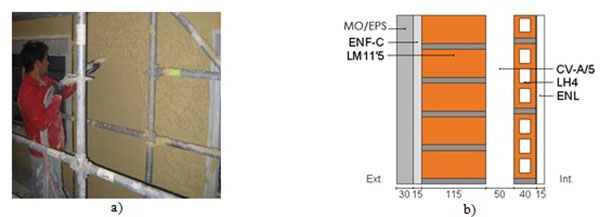
The improvement at the rooftop was designed in a similar way: the thermal insulation was installed from the outside, transforming it into reversed flat roof (Fig. 12). The Thermal transmittance coefficient U achieved with this solution was 0.59 W/m2K.

It is worth mentioning that the improvement of the façade appearance as a result of the retrofitting had an important effect: an increase in the property value. The comparison of the façade picture before and after the project clearly reveals the indirect effect (Figs. 12 and 13).
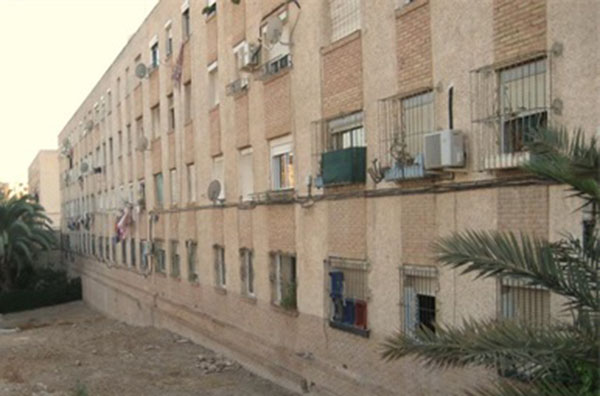
Evaluation of the Original and Improved Status
In order to analyse the buildings’ behaviour at a deeper level, as they consist of similar modules with 3 or 4 floors, an energy simulation from the decomposition of the buildings into 12 modules was performed Fig. (14). It presented, either by their number of floors or by their height, specific conditions on their thermal performance, so that the following aspects were taken into account as relevant: boundary conditions of the thermal envelope and height of the modules.
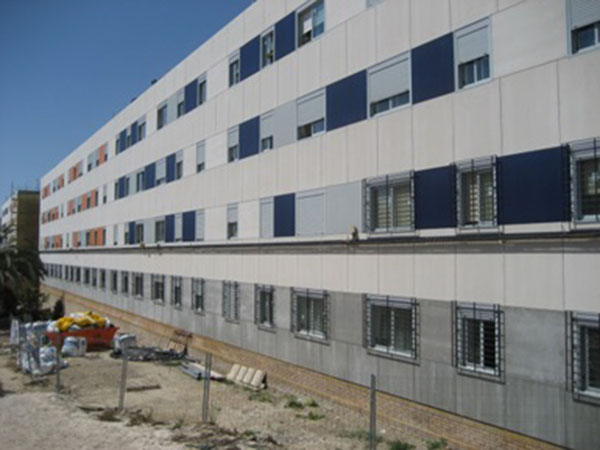

In order to analyse if the partial impact of each of the improvement measures is over the total, a series of possible situations were simulated. The initial status and the final status in each possible scenario were compared, analysing the improved constructive elements, both individually and globally. Table 1 summarises the different considered scenarios:
| Simulation type | Previous status | Final status |
|---|---|---|
| Type 1 | Original state | Improved status 1 (façades and thermal bridges) |
| Type 2 | Original state | Improved status 2 (rooftops) |
| Type 3 | Original state | Improved status 3 (windows) |
| Type 4 | Original state | Improved status 1, 2 and 3 (façades and thermal bridges, rooftops and windows) |
The aim was to know the partial impact of each of the improvement measures, in order to detect the relation of each improved element with its improvement rate. It should be noted that the sum of the improvements calculated partially is not equal to the improvement status calculated globally, as the simulation process is more complex and some components on the envelope affect the other components simultaneously. However, the level of error considering this is small.
The most important result was the improvement of the thermal comfort and the life quality of the users. It is worth to be noted as a high number of dwellings lacked heating and cooling systems, and this intervention does not bring up the installation of any heating or cooling systems. Therefore, taking this into account, 4 simulations were carried out per modelled module, with the number of simulations being 36.
Regarding the performance of the final solutions, U values, heating and cooling needs were determined taking into account the Spanish regulation (Building Technical Code), for Alicante city.
Improvement Results by Constructive Elements
Façades and thermal bridges improvements presented a much higher heating demand reduction (45%) than cooling demand reduction (14%).
Windows improvements presented similar demand reduction in heating (21%) and in cooling (20%).
The rooftop improvement presented a reduction in heating demand (14%) similar to the reduction in cooling demand (12%).
The improvement level of each intervened element depends mainly on the surface it represents on the buildings’ thermal envelope, the orientation of those elements of the envelope and the compactness of the studied module. In this text, the compactness is the relationship between the volume enclosed by the thermal envelope and the amount of the surfaces of this envelope in contact with the external environment.
The reduction of CO2 emissions by intervened element is greater at façades and thermal bridges (26%) than at rooftops (11%) and windows (17%) (Graph 2).

The improvement by decreasing thermal transmittance coefficient in each element is shown in Graph (3), which also compares the maximum levels of U established by Spanish regulation (CTE) to show the level of performance that is reached by the intervention.
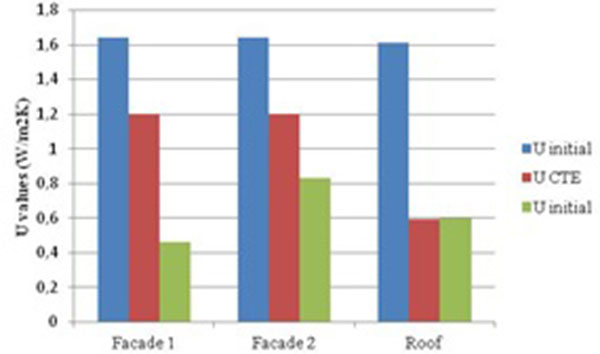
Global Results by Reduction in Demand, Consumption and CO2 Emissions
Graph (4) contains information on the reduction percentages in CO2 emissions, demand and consumption achieved with the suggested intervention. The global reduction in demand is 52%, being greater reduction in heating than in cooling demand.
As a result of the intervention, cooling is sensitively greater than heating demand. It must be taken into account that the climate zone is Alicante B4, characterised by a sever summer. On top of that, the blocks’ façades orientation to east and west is the most detrimental (with the higher radiation during summer).
The percentage in energy consumption saved is 52%. We must add as a result of the upgrading, not only the reduction in the energy bill of the users, but the improvement in their comfort and living standards, more remarkable taking into account that many dwellings lack heating and, even less, cooling systems. A notable reduction in the number of discomfort hours inside the households is achieved, obviously.
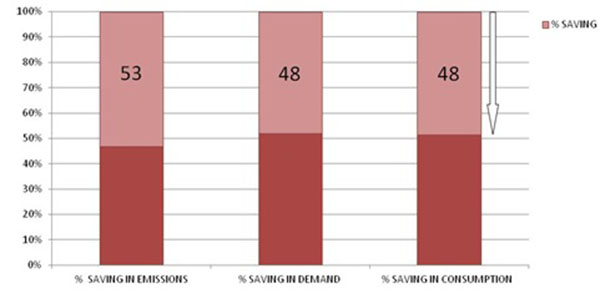
It is important to point that the official energy performance evaluation programmes, require working at some theoretical set temperatures. In this regard, if these temperatures are not reached, the program considers some default systems in order to guarantee the established comfort temperatures. Therefore, the obtained results for the simulation may not be a real representation. In fact, the energy poverty situation that many families in the neighbourhood suffer stops them from paying an energy bill that would allow them to reach those comfort temperatures. Therefore, there is an important difference between theoretical and real consumption.
With the theoretical conditions for simulation, assuming heating system with gasoil and an electric cooling system with the established costs by the latest fees (which are 0.048 €/kWh for gasoil and 0.12 €/kWh for electricity), annual savings per dwelling are approximately of 170.45 € for heating and cooling altogether, in standard conditions.
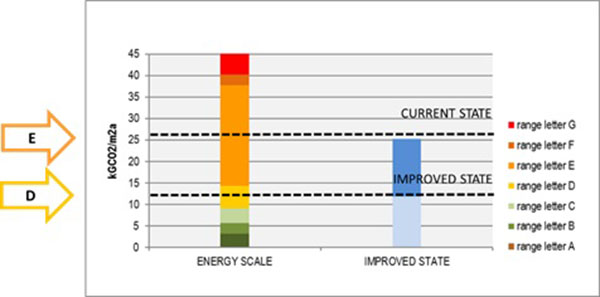
- Initial consumption: 3.7 €/m2 dwelling per year
- Final consumption: 1.776 € /m2 dwelling per year
- Savings: 1.924 € /m2 dwelling per year
The global savings in CO2 emissions is of 47%. In addition to the improvement in energy parameters, there is an improvement in the scale of energy qualification against energy qualification for new construction block buildings (for existing buildings, at the time when the study was carried out, the scale was not published, it includes two more letters below E). The achieved qualification is a D, which is equal to 13.4 kgCO2/m2year, (Graph 5).
Assuming an average saving of 13.8 kgCO2/m2 dwelling per year, the saving in emissions for a standard dwelling is 994 kgCO2 per year. This quantity, for the total 324 dwellings would result in an annual total saving of 322 TCO2.
From the results obtained by the application of the improvement measures to standard envelopes, it can be concluded that even increasing the total thickness of the insulation layer to 80mm at the same time in all the elements of the envelope, (the original project established 40mm), it is impossible to reduce the emissions with the purpose of modifying the original energy evaluation, graded with a D.
If, in addition to increase 40 mm the thermal insulation in roof and walls, compared with the original design (80 mm in total, with a conductivity of 0.04W/m2K), the glass (3.3 W/m2K) and the frames (3.3 W/m2K) are improved simultaneously, and a mix system of DHW and biomass heating systems are added, the qualification obtained would be an A and would be a high energy efficiency building.
Acting on the DHW and heating systems separately a qualification of C was obtained but only using biomass as fuel. However, if both systems are combined, a B score can be achieved if biomass is still used. Thus, a mix system of DWH and heating systems, with a high performance seasonal boiler (95%) will also obtain an improvement on the energy qualification, reaching a C level by using natural gas as fuel or an air-water heating pump.
To obtain a qualification of A, an important effort must be done, not only on the envelope but also on the systems, with the use of renewable energies due to the low emissions produced by this type of fuel.
Although the residential unit’s trend is very similar, a slightly better performance can be observed on the 4 stories units compared to the 3 stories units by square meter (kgCO2/m2 a year). It is due to a higher compactness of the first one. Certainly, the global emissions (kgCO2 a year) of the 4 stories units are greater than the 3 stories blocks, because they have a larger number of houses, although the emissions ratio per square meter is lower.
Intervention Costs Evaluation
If we relate the improvement percentage on thermal transmittance reduction, with the improvement percentage on emissions reduction and the price of m2 on roof, façades and windows, we acknowledge that windows are more expensive (252 €/m2) although they do not take into account the maximum emissions reduction, which is given by the façades with a cost of 42 €/m2. Roofs improvements are the cheapest (28€/m2), but they are the least contributing to emissions reduction. If this analysis is realised with total prices per element, we can verify how the façades are precisely the most relevant element regarding emissions reduction, but with the most expensive cost, approximately 760,000 € (a 50% of the total cost of the intervention on the envelope). In fact, rooftops improvements represent 177,000 € (a 12% of the total price of the intervention), much cheaper than the façades improvements, although they are the ones with less effect on emissions reduction. It must not be forgotten that, due to the shape of the blocks, the total façade area adds up to 18,000 m2, against 6.300 m2 of the rooftops, almost 3 times more.
If the total cost of the intervention of each element (rooftops, windows and façades) is reflected on the dwellings’ m2, the following costs are given:
− Rooftops: 7.59 € /m2dwelling
− Windows: 25.36 € /m2dwelling
− Façades: 32.52 € /m2dwelling
− Total intervention: 65.47€ /m2dwelling
Despite the long investment-return periods, the results revealed that the houses which were out of the neighbourhood real estate market before the improvement, entered again in it after the refurbishment, showing a slight increase in the number of sales and purchases. Another effect that should be highlighted is the increase in property value that the intervention has generated. The comparison of the façade picture before and after the project clearly reveals the indirect effect (Figs. 14 and 15).
Thus, a deeper economic study considering these aspects, not just the technical solutions, may reduce the investment-return periods.
All the costs described are total costs including labour and materials indirectly.
CONCLUSION
To be able to analyse the actions to be implemented, the most representative residential units were considered based on the greater energy score evaluation and according to the official energy scale. In particular, the unit type B, situated between dividing walls and 3 stories high, and the type B’, with a similar situation between dividing walls and 4 stories high but with a different compactness.
Regarding the Improvements Proposed
It is impossible to modify the original energy evaluation, graded with a D, only with isolated intervention on the envelope, even increasing to double the total thickness of the insulation layer from the first project.
If apart from acting on the envelope, according to the technical project, an intervention on the systems would have been implemented, the analysis of the results obtained from the application of standard measures concluded that, in general, the emissions are reduced but not in a sufficient manner to achieve a C energy qualification. Only with the use of biomass for DHW or heating, an energy efficiency qualification increase can be obtained.
A qualification C can be achieved combining interventions on roofs, walls and windows.
Combined interventions on the thermal envelope and installing systems using biomass as fuel, a B score can be achieved.
In any case, the improvement of the systems with high efficiency equipment produces a substantial improvement on the qualification, scoring a maximum of C, and more if it is combined with improvements on the envelope.
It is only possible to achieve a qualification of A, improving the thermal systems with an important economic effort, through the installation of renewable energies.
Compactness is defined as the relation between the total air treated volume of the building if compared with the envelope surface area in contact with the exterior environment. The energy behaviour between units is sensibly different depending if B’ (4 stories) has a compactness level higher than the other B unit (3 stories), because with a similar construction quality (equal values of U on the envelope) the energy demand is reduced by square meter (kWh/m2 a year). This occurs because the area of thermal transmission is smaller on the building with greater compactness. Therefore, greater compactness improves the energy efficiency if calculated based on surface and not in global units (kWh a year). It is evident that, globally, the 4 stories unit has greater emission and consumptions as it has a higher number of housing units.
The Importance of Demand Reduction and Solar Orientation
Because of the conditions of the buildings, occupied by low income citizens, the results focused, mainly, on studying how the demand can be reduced. In this sense, the savings obtained for the heating demand are close to 72%, while the reduction of air conditioning demand is estimated at 52%. This causes that on the improved-final result, the demand for air conditioning is higher than the heating demand.
It should be highlighted that these results are produced by the shape of the building on the microclimate created on its emplacement. Therefore, if solar contribution is analysed, it can be concluded that the studied building has a linear form with façades to East and West orientation. As a result, the solar radiation on the eastern and western façade is much higher in summer than in winter season, while the northern façade receives low direct radiation and mainly in summer time. Therefore, on the East and West façades, the use of solar protection systems should be emphasized, such as awnings or something similar, as the great benefits for reducing solar radiation in summer are demonstrated. The improved rooftop also results as being very beneficial in avoiding this overheating situation.
Regarding the Influence of Compactness
The buildings with a higher compactness have a slightly better performance. However, the global emissions of these constrictions are greater, because they have more houses, and the emissions ratio per square meter is lower.
Regarding Social Aspects
The most relevant result is the improvement of the thermal comfort and the life quality of the users, especially if the high percentage of housing units is considered that do not have any heating or air conditioning systems along with the absence of such systems on the refurbishment intervention. In consequence, the investment-return periods, if there is no real energy consumption, reach 20 years, making unviable, initially, this type of intervention.
Regarding Economic Aspects
The energy retrofit of the envelope with external thermal insulation revealed that houses that were out of the neighbourhood real estate market entered again in it after the refurbishment, showing a slight increase in the number of sales and purchases.
Thus, a deeper economic study considering these aspects, and not just the technical solutions, may reduce the investment-return periods.
This paper reveals the importance of energy refurbishment in residential buildings, especially in social housing, and how important it is to work for improving the processes, the financial mechanism or launching awareness campaign for the users.
In addition to achieving tangible results in emissions reduction, energy refurbishment permits a transformation of the construction sector, highly affected by the economic crisis, attending the necessities of groups in risk of suffering energy poverty as well as creating green jobs.
In addition, this paper aims to point out the important exemplary role that governments should have in the regeneration of vulnerable neighbourhoods of our cities. These goals are not only focused on reducing CO2 emissions, but also on improving the quality of life of people. It has been demonstrated that without large financial investments, prioritizing what is important and durable, an interesting refurbishment project can be undertaken.
This experience demonstrates the social character that has motivated the intervention in the buildings at this neighbourhood, beyond the regulation. The benefits generated by the energy retrofit are worth noting in terms of improving the urban scene and rising property values.
CONFLICT OF INTEREST
The authors confirm that this article content has no conflict of interest.
ACKNOWLEDGEMENTS
Our special gratitude to the Municipal Housing Board of Alicante (Spain), especially to Gaspar Mayor, manager of the office, and Javier García, board’s architect, for the information provided for the elaboration of this paper.


